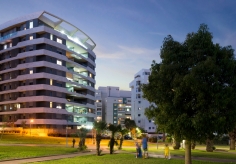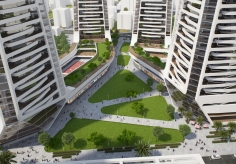The turning point of the synagogue began with the destruction of the First Temple, when Jews in the Diaspora required an alternative to the Temple and the sacred rituals that took place within. Gradually, sacrificial offerings were replaced by prayer, and the synagogue became a reference to the Temple itself. However, one should not view the synagogue merely as a symbol or a place of worship, but as a center with an essential role in the community.
In many countries, the synagogue is the very hub of Jewish life – an institution that connects people, discourages assimilation and safeguards the religious, national identity. This has also become the role of synagogues in Israel, and they will always act as a communal binding agent for groups and families. Accordingly, in addition to the Sanctuary and the customary women’s section, many synagogues also house classrooms, libraries, ritual bathing facilities and halls for festive events.
This planning scheme allows for a variety of activities, bringing many Jews – including those who do not pray on a daily basis – closer to the Jewish community and tradition. To combine the very inner-directed action of prayer with public and communal activities is the real challenge behind the design of the modern synagogue.
Throughout many hundred years, modules were used. Synagogues were designed either according to local architectural traditions in the Diaspora, or to those of the ruling powers in Palestine. Nowadays, a local architectural tradition is still in the making. This stresses the need to create a new vocabulary – one that retains the spiritual values of the Jewish tradition on one hand, and in addition, is tailored to suit the needs of all, here and now.
 The basic building blocks of the architectural vocabulary we created are made up of the color white and a clever means of using shading to fit local climatic conditions, known for the continuous onslaught of light and heat. A delicate mashrabiya latticework creates a gentle interplay of light and shadow, lends depth and complexity to the facades and casts patterns on the floors and walls of the interior. The transparency in the public areas provides an inviting connection between the exterior and the interior, while the transparent part within the Sanctuary turns the gaze upwards to the sky, creating an experiential merging with nature. The entire building has the appearance of a solid white mass that has been delicately sculpted, polished and crafted by the hands of a master craftsman.
The basic building blocks of the architectural vocabulary we created are made up of the color white and a clever means of using shading to fit local climatic conditions, known for the continuous onslaught of light and heat. A delicate mashrabiya latticework creates a gentle interplay of light and shadow, lends depth and complexity to the facades and casts patterns on the floors and walls of the interior. The transparency in the public areas provides an inviting connection between the exterior and the interior, while the transparent part within the Sanctuary turns the gaze upwards to the sky, creating an experiential merging with nature. The entire building has the appearance of a solid white mass that has been delicately sculpted, polished and crafted by the hands of a master craftsman.
 This dialectal tension between architecture and sculpture results in a place for imagination and varying interpretation. One may regard the building as a cloud – to every beholder comes a different image that unites them with their inner being. Thus, a place of worship and introspection becomes a landmark, a meaningful focal point in its surroundings.
This dialectal tension between architecture and sculpture results in a place for imagination and varying interpretation. One may regard the building as a cloud – to every beholder comes a different image that unites them with their inner being. Thus, a place of worship and introspection becomes a landmark, a meaningful focal point in its surroundings.


